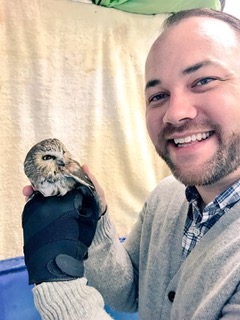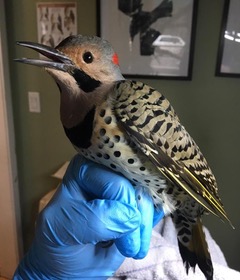Since the end of the last Ice Age, birds have migrated between the Arctic tundra and the Caribbean along the Atlantic Flyway, a migration route that passes over New York City. Drawn by an evening glow, the birds often fly into the city by night, drop into green spaces to forage, and leave the city by early morning.
In the rise of the modern age, the glass towers of the New York skyscape have made that migration treacherous. Today, nearly a third of the world’s birds migrate through the city in the spring and fall, often hitting windows reflecting outdoor foliage. According to scientists at New York City Audubon, an estimated 90,000 to 230,000 birds die in New York City every year from “bird strikes,” or collisions with glass. Most accidents happen during the early morning, according to research by the American Bird Conservancy.
Birds now have protection thanks to a “bird friendly glass” bill that was approved by the New York City Council last December. “A lot of these bird deaths are totally avoidable, and it is incumbent on us to do what we can to prevent these animals from dying unnecessarily,” said Corey Johnson, City Council speaker and a wildlife advocate. Brooklyn council member Rafael Espinal introduced the bill.

This is the first law in New York City that is centered on birds, and will go into effect in December 2020. The city joins Portland, Oregon, San Francisco, San Jose, California, and Toronto, which already have bird friendly laws in place according to Katherine Heintz, executive director of NYC Audubon.
The bill requires 90 percent of glass in newly constructed and altered buildings to be “bird safe,” or visible to birds, in keeping with a rating system developed by the American Bird Conservancy. The city has 45,000 active construction projects, according to Melanie La Rocca, commissioner of the New York City Department of Buildings, who supports the new law.
The regulations will only apply to the lowest 75 feet of a building, an approximate tree canopy height. Half of collisions take place in low-rise buildings up to about 11 stories, said Dr. Christine Sheppard, director of the American Bird Conservancy’s glass collisions program. The bill also applies to glass balcony railings and glass corners, as well as 12 feet above green roofs.
NYC Audubon has documented bird strikes since 1997, when it founded Project Safe Flight, a conservation effort to rescue injured birds and prevent future collisions. Volunteer Terence Zahner, who photographs birds in north Central Park, has observed 110 different species in the city. He started to find dead birds below the Circa Central Park, a residential building on Frederick Douglass Circle in Harlem made primarily of glass, beginning in the fall of 2017.
In the fall, Zahner collected 107 “collision victims” nearby, comprising 28 different species. While Zahner is encouraged by the bill, he said that “there is still an immense amount of effort needed to monitor and address existing problem buildings.”
Rita McMahon, co-founder of city-based nonprofit Wild Bird Fund, said that her rehabilitation centers are caring for over 300 birds in its Manhattan and Queens locations, and it’s not unusual to receive several dozen birds in a single day. “We make them comfortable, safe, warm, give them anti-inflammatories. But their brains are swelling from the impact,” she said.
Scientists often teach architects about the problem and work together on solutions. The American Bird Conservancy’s Sheppard said that the 2014 expansion of the Jacob K. Javits Convention Center – once a top “bird-killer” – is a leading example. The building’s glass was silk screened with small ceramic dots, called a “frit technique,” to reflect sunlight and conserve energy. An added benefit was that the glass was bird safe, and due to its dual-purpose didn’t increase costs.
Today, bird deaths at Javits are down by 90%. The building’s nearly seven-acre green roof also attracts migrating birds. The Circa Central Park, where Zahner continues to find dead birds, was designed by the same firm that designed the Javits Center. But NYC Audubon’s Adams said it was impossible to persuade developers to use bird safe glass without a binding law.
For now, Zahner continues to collect and freeze dead birds, handing them over to NYC Audubon, where they will be preserved at the American Museum of Natural History. “Seeing birds faced with extinction… these might be an important scientific record in the future,” he said.

